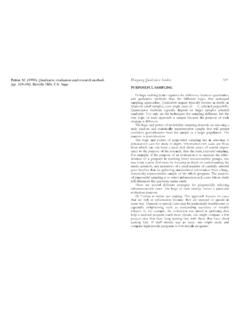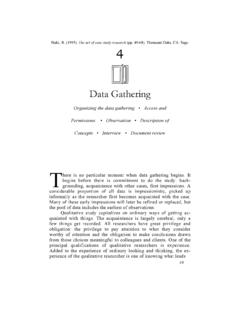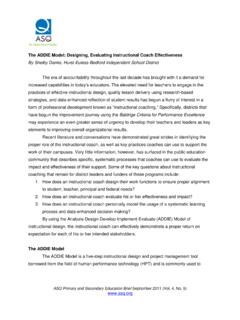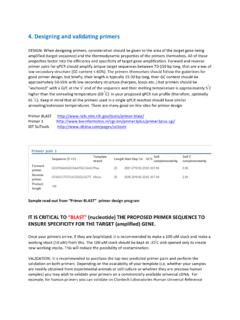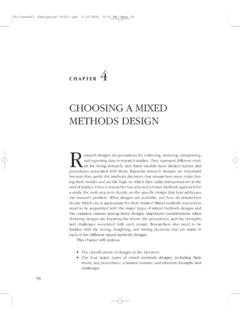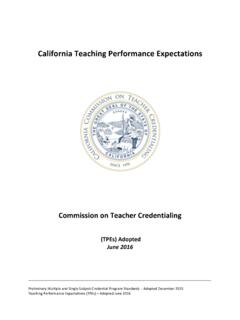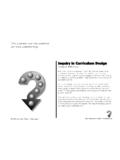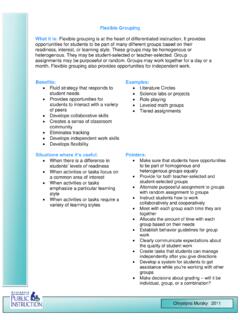Transcription of Patton, M. (1990). Qualitative evaluation and research ...
1 Patton, M. (1990). Qualitative evaluation and research methods designing Qualitative Studies 169. (pp. 169-186). Beverly Hills, CA: Sage. PURPOSEFUL SAMPLING. Perhaps nothing better captures the difference between quantitative and Qualitative methods than the different logics that undergird sampling approaches. Qualitative inquiry typically focuses in depth on relatively small samples, even single cases (n = 1), selected purposefully. Quantitative methods typically depend on larger samples selected randomly. Not only are the techniques for sampling different, but the very logic of each approach is unique because the purpose of each strategy is different. The logic and power of probability sampling depends on selecting a truly random and statistically representative sample that will permit confident generalization from the sample to a larger population.
2 The purpose is generalization. The logic and power of purposeful sampling lies in selecting in formation-rich cases for study in depth. Information-rich cases are those from which one can learn a great deal about issues of central impor- tance to the purpose of the research , thus the term purposeful sampling. For example, if the purpose of an evaluation is to increase the effec- tiveness of a program in reaching lower-socioeconomic groups, one may learn a great deal more by focusing in depth on understanding the needs, interests, and incentives of a small number of carefully selected poor families than by gathering standardized information from a large, statistically representative sample of the whole program. The purpose of purposeful sampling is to select information-rich cases whose study will illuminate the questions under study. There are several different strategies for purposefully selecting information-rich cases.
3 The logic of each strategy serves a particular evaluation purpose. (1) Extreme or deviant case sampling. This approach focuses on cases that are rich in information because they are unusual or special in some way. Unusual or special cases may be particularly troublesome or especially enlightening, such as outstanding successes or notable failures. If, for example, the evaluation was aimed at gathering data help a national program reach more clients, one might compare a few project sites that have long waiting lists with those that have short waiting lists. If staff morale was an issue, one might study and compare high-morale programs to low-morale programs. 170 Qualitative DESIGNS AND DATA COLLECTION designing Qualitative Studies 171. The logic of extreme case sampling is that lessons may be learned deviate from the norm. Observing the reactions to someone eating like a about unusual conditions or extreme outcomes that are relevant to pig in a restaurant and then interviewing people about what they saw improving more typical programs.
4 Let's suppose that we are interested and how they felt would be an example of studying a deviant sample to in studying a national program with hundreds of local sites. We know illuminate the ordinary. that many programs are operating reasonably well, even quite well, and The Peters and Waterman (1982) best-selling study of "America's that other programs verge on being disasters. We also know that most best run companies," In Search of Excellence, exemplifies the logic of programs are doing "okay." This information comes from purposeful, extreme group sampling. Their study was based on a sample knowledgeable sources who have made site visits to enough programs to of 62 companies "never intended to be perfectly representative of have a basic idea about what the variation is. The question is this: How industry as a whole .. [but] a list of companies considered to be should programs be sampled for the study?
5 If one wanted to precisely innovative and excellent by an informed group of observers of the document the natural variation among programs, a random sample business scene" (Peters and Waterman, 1982: 19). would be appropriate, preferably a random sample of sufficient size to Another excellent example of extreme group sampling is Angela be truly representative of and permit generalizations to the total Browne's (1987) study, When Battered Women Kill. She conducted in-depth population of programs. However, some information is already available studies of the most extreme cases of domestic violence to elucidate the on what program variation is like. The question of more immediate phenomenon of battering and abuse. The extreme nature of the cases interest may concern extreme cases. With limited resources and limited presented are what render them so powerful.
6 Browne's book is an time an evaluator might learn more by intensively studying one or more exemplar of Qualitative inquiry using purposeful sampling for applied examples of really poor programs and one or more examples of really research . excellent programs. The evaluation focus, then, becomes a question of (2) Intensity sampling. Intensity sampling involves the same logic as understanding under what conditions programs get into trouble and extreme case sampling but with less emphasis on the extremes. An under what conditions programs exemplify excellence. It is not even intensity sample consists of information-rich cases that manifest the necessary to randomly sample poor programs or excellent programs. phenomenon of interest intensely (but not extremely). Extreme or The researchers and intended users involved in the study think through deviant cases may be so unusual as to distort the manifestation of the what cases they could learn the most from and those are the cases that are phenomenon of interest.
7 Using the logic of intensity sampling, one seeks selected for study. excellent or rich examples of the phenomenon of interest, but not In a single program the same strategy may apply. Instead of studying unusual cases. some representative sample of people in the setting, the evaluator may Heuristic research uses intensity sampling. Heuristic research draws focus on studying and understanding selected cases of special interest, explicitly on the intense personal experiences of the researcher, for for example, unexpected dropouts or outstanding successes. In many example, experiences with loneliness or jealousy Coresearchers who instances more can be learned from intensively studying extreme or have experienced these phenomena intensely also participate in the unusual cases than can be learned from statistical depictions of what the study (see Chapter 3).
8 The heuristic researcher is not typically seeking average case is like. In other evaluations detailed information about pathological or extreme manifestations of loneliness, jealousy, or special cases can be used to supplement statistical data about the normal whatever phenomenon is of interest. Such extreme cases might not lend distribution of participants. themselves to the reflective process of heuristic inquiry. On the other Ethnomethodologists use a form of extreme case sampling when hand, if the experience of the heuristic researcher and his or her they do their field experiments. Ethnomethodologists are interested in coresearchers is quite mild, there won't be much to study. Thus the everyday experiences of routine living that depend on deeply researcher seeks a sample of sufficient intensity to elucidate the phe- understood, shared understandings among people in a setting (see nomenon of interest.)
9 Chapter 3). One way of exposing these implicit assumptions and norms The same logic applies in a program evaluation . Extreme successes on which everyday life is based is to create disturbances that or unusual failures may be discredited as being too extreme or un- 172 Qualitative DESIGNS AND DATA COLLECTION designing Qualitative Studies 173. usual for gaining information. Therefore, the evaluator may select cases (4) Homogeneous samples. In direct contrast to maximum variation that manifest sufficient intensity to illuminate the nature of success or sampling is the strategy of picking a small homogeneous sample. The failure, but not at the extreme. purpose here is to describe some particular subgroup in depth. A. Intensity sampling involves some prior information and considerable program that has many different kinds of participants may need in-depth judgment.
10 The researcher must do some exploratory work to determine information about a particular subgroup. For example, a parent the nature of the variation in the situation under study One can then education program that involves many different kinds of parents may sample intense examples of the phenomenon of interest. focus a Qualitative evaluation on the experiences of single-parent female (3) Maximum Variation sampling. This strategy for purposeful sam- heads of household because that is a particularly difficult group to reach pling aims at capturing and describing the central themes or principal and hold in the program. outcomes that cut across a great deal of participant or program Focus group interviews are typically based on homogeneous groups. variation. For small samples a great deal of heterogeneity can be a Focus group interviews involve conducting open-ended interviews with problem because individual cases are so different from each other.
